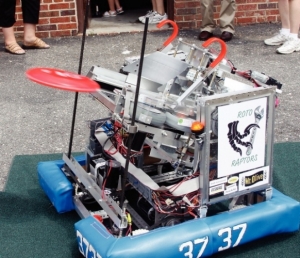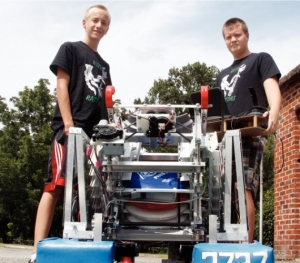Wanted: robot wranglers
By Josh Ellerbrock
Published in News on August 28, 2013 1:46 PM

News-Argus/BOBBY WILLIAMS
The Velociraptor chucks a Frisbee in the parking lot of Herman Park Center. The 110-pound robot was designed and built in six weeks by 18 teenagers in the 4-H Robotics Club.

News-Argus/BOBBY WILLIAMS
The two Finch brothers, Stephen, left, and Christopher, stand by the 4-H Robotics Club's creation, the Velociraptor. Christopher is holding the device used to steer the robot. The portable laptop and joystick control the robot through an onboard WiFi network.
Electric motors hum, and spinning wheels rev to speed.
"All clear"
The "bat" rears back and snaps.
SCHWUuck.
The Frisbee shoots forward spinning rapidly and floating on a column of air. As the plastic disc comes to rest 30 feet away, the little box of gears, wires and wheels hums again and reloads for another shot.
Welcome to the 4-H Robotics Club, where the arenas are inhabited by steel and plastic creations and the humans stand on the sidelines with joysticks in hand. It's a competition where brains will always defeat brawn, and the sport's athletes are much more worried about fine-tuning motors than fine-tuning muscles.
Out in the roboting world, Goldsboro's team -- comprised of mechanically-minded teenagers and their single robot -- is known as the Roto Raptors or Team 3737, and they are gearing up for their fifth season.
*
Today's lesson: Robot Driving 101. The Finches, the family with the most experience with the robot, won't be able to take the controls during an upcoming demonstration, so a few others of the 18-member 4-H Robotics Club team need to learn to drive.
Thirty minutes later, the little robot has been run through its paces. It fired a few Frisbees at the wall, almost took out a picture frame, shot member Christopher Finch, 16, in the head, got its gears misaligned and then ran through a man-made obstacle course before running out of juice.
And to think, in January, this remote-controlled Frisbee thrower -- known as the Velociraptor -- was little more than a few motors, several lines of code and steel scrap.
*
The process works like this. Teams across the nation that participate in the FIRST (For Inspiration and Recognition of Science and Technology) Robotics Competition are given an objective at the beginning of the season that the robots must be designed around.
For example, the 2012 season objective -- called Rebound Rumble -- featured robots attempting to shoot foam basketballs into standard-sized basketball hoops placed at different heights. A secondary objective featured robots balancing on bridges. In the regional competition, Team 3737 placed 17th out of 56.
This past season, in which Velociraptor competed in March, robots were built to shoot plastic discs into slots. The secondary objective was climbing a 10-foot tall steel pyramid. The team placed 13th out of 55.
*
But FIRST isn't all about competition. More than anything, the competition is used as a tool to engage students' scientific curiosity and to further their technological skills.
"While building the robot, I learn something new everyday," Josh Spence said.
Once the 2014 objectives are announced in January, teams will have six weeks to complete their robots -- from design, funding, marketing, programming and the final build.
Every member of the team has a different job, yet all contribute to the robot, even if it's just sanding down an edge for safety reasons.
One young man who recently graduated from the program, Daniel Alley, spent last fall learning Java so he could program the robot.
"I was the team's only programmer, so I kind of had to," Alley said.
Other teammates learn the basics of electrical engineering or study up on mechanical tools. Fall is the team's training season as they learn on the skills they may need during the hectic six-week building period, because these creations all the students' own. They are responsible for the designs. They may get some advice and direction from their club advisers and sponsors, but the adults are only allowed limited handling of the robot and its parts.
At the end of those six weeks, the robots are bagged and not to be touched. Last year, the Roto Raptors used this time to create a wiring checklist -- robots can still be seen just not touched -- and to finish up any other projects related to the competition.
Because as many of the team members reiterated, the 4-H Robotics Club isn't just about robots -- it's described by FIRST as being as "close to real world engineering that a student can get."
That includes raising funds, community interest and team spirit.
A marketing team first creates a brand, which is then brought to sponsors to help raise the $5,000 needed to join the regional competition. Sponsor and grant funds also go toward robot parts such as wiring, servo motors or optical sensors. Funding can make or a break a team, and coach Anne Finch has seen both types -- supported teams that can build multiple robots and smaller ones that can only put out a shell of a robot.
The spirit team helps keep team morale up while making their name recognizable to others in the regional competition.
"You really want to get known in the competition," Stephen Finch, 14, said. "It's a real sports event. It really is."
"It's almost like you're building something and then selling it", Laura Alley, the team's co-director, said.
Then in March, the team travels to Raleigh to participate in the North Carolina Regional Competition, where, as many of the Roto Raptors say, the real fun begins.
"Until they go to competition, they don't understand how fun this can be," Mrs. Finch said.
*
Fifty-five teams. Three days. One arena.
In the packed arena, Frisbees fly, robots -- and their handlers -- try to cut other off from the best positions, and some robots stay still as one of the thousands of parts in their complex systems fail.
Meanwhile, human teammates and fans in brightly colored shirts, cheer in a roar typically only heard at college sporting events.
Here, robots compete to go the national arena to earn fame and glory -- and lots of scholarship money for their high-school handlers. Only members of the top team move on to the national competition.
The Roto Raptors spent the first day of the 2013 competition putting the final touches on Velociraptor, except not everything worked as well as it could have. The Goldsboro team, after a frenzy of wiring, still didn't have their Frisbee shooter up and running like they hoped. But that didn't stop them from trying.
During the rushed fix-it job on day one, other team members walked around the pits asking questions of other teams, watched other robots practice and gathered information to put together a portfolio on every other team.
The second day, robots ran through their qualifying rounds to show off what they could do, and Velociraptor placed 12th.
On the final third day, the tournament matches the top three robot alliances against each other.
The top eight teams from the qualifying rounds then picked their teammates for the final rounds, allowing the Roto Raptors to move into the eighth spot and become a team captain.
Their final round, however, was mostly unsuccessful. Facing off against the region's top team, Mechanical Mayhem, their opponent's success stemmed from a Frisbee launcher that could shoot from across the arena straight into the top slot. Velociraptor, however, just zoomed around on the ground -- its Frisbee shooter out of commission.
As for the steel pyramid climbing, Velociraptor was able to suspend itself from the bottom bar thanks to a simple solution of hooks on top of their manual loader, which was strong enough to suspend the 110-pound little guy from the bottom bar and gained the overall alliance an extra 10 points.
"We didn't win against them, but it was fun," Mrs. Finch said.
*
The robot only has a few months left before it's disassembled for parts for the new season. Keeping it intact without reusing old parts would cost the team a few extra thousand dollars.
"We would rather go to competition than leave it intact," Mrs. Alley said.
Until then, it will be used to take part in one more small competition and a few demonstrations at county schools as the team looks to recruit new members.
"People can find it and really get into it. I just think it is a great program," Mrs. Alley said.
And if any students are on the fence, consider that big scholarships are given out to the winning teams. FIRST, the company that organizes the competition gives out $1 million in scholarships to successful teams and outstanding team members. Joining the club also allows members to qualify for 4-H scholarships.
But there are, however, other reasons to join.
"The main thing is it's tons of fun," the elder Finch brother said.
"I heard about it. 'Sure, it's robots, why not?' It's been a large amount of fun," Spence said.
Adult robot enthusiasts can also join the club if they wish. The 4-H Robotics Club is also looking for older men and women who wish to give aid as mentors -- people with specialized knowledge about mechanical, electrical and software systems for the robot and business and marketing knowledge for the team overall.
The first parent meeting for the 4-H Robotics Club is Sept. 6 in the kitchen of the Wayne Counter Center on Chestnut Street in Goldsboro. For more information on the club or anyone interested in joining can call Laura Alley at 919-738-7940.
